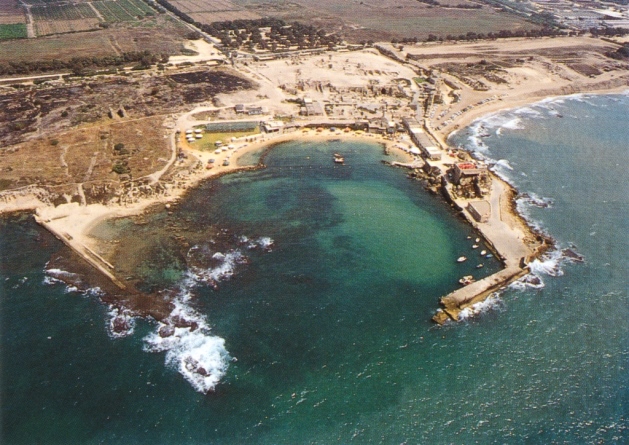The engraved limestone block is hard to read after all this time, but with a little effort you can make out the name “Pontius Pilatus” and fragments of the words “praefectus Iudaeae,” or prefect of Judea.

The stone that sits here in Caesarea, overlooking the azure blue Mediterranean, is an exact replica, of course. The real thing, discovered just 50 years ago, is safe in the Israel Museum in Jerusalem.
In a land that is an archeological treasure chest, Caesarea is one of the most precious jewels. At its height some 2,000 years ago, this was among the greatest cities of the Roman world, boasting the biggest harbour in existence and surpassing even Jerusalem for its beauty and modernity.
But Caesarea was destroyed many times and rebuilt, razed finally by the invading Mamalukes in the 13th century. The ruins sat buried beneath the earth and the sea until excavation began in the early 1960s, and that work continues today.
What has been uncovered so far is a significant tourist destination in Israel, a little more than an hour’s drive north from Tel Aviv. Even on a Monday morning, the site is crowded with visitors.

Take a few hours to wander the ruins and soak in the history, then head off to one of the cafés that line the present waterfront for a bite to eat and perhaps cool off with one of Israel’s famous iced mint lemonades, then check out the shops for jewellery or original artworks or other souvenirs.
The Caesarea visitor centre includes an interactive, animated and very entertaining electronic guide that recounts the city’s past.
There had been a Phoenician settlement on this spot for centuries, but it was a Roman civil war that put Caesarea on the map. Judea sparred for territory with its neighbour to the west, Egypt, and its queen, Cleopatra. Her lover, Mark Anthony, finally gave her Judea as a gift, much to the chagrin of the country’s king, Herod.
As war broke out between Anthony’s faction in Rome and that of Gaius Octavius, Herod threw his full support behind the latter. Octavian won the war — we all know how Tony and Cleo wound up — became emperor under the name Caesar Augustus, and as a reward for Herod’s loyalty gave the Judean king his land back.

And build Herod did.
What today is a small rocky spit was once a magnificent harbour that stretched out more than 500 metres into the sea. It was built with revolutionary technology, a mixture of volcanic ash, rubble and lime that was lowered in wooden frames and hardened in water to make a type of concrete.
You can still see some of those enormous blocks up close if you know how to dive. Caesarea boasts the world’s first underwater museum, featuring those port foundations, the remains of a lighthouse and a Roman shipwreck. Divers can choose from four signposted (in English as well as Hebrew) trails, including a shallow one for snorkellers, and stop at 36 sites ranging from 2 to 9 metres deep.
Back to Herod’s time. The harbour’s seawall was crowned by a soaring lighthouse containing fires that burned 24/7 and could be seen by ships far away. Giant bronze statues marked the sandbars around the entrance to the deep outer harbour.
The city itself, which may have been home to as many as 100,000 people, was laid out in a Roman grid pattern, with sewers, broad paved streets, temples (the Pilate stone is from the dedication of one in about 30 A.D.), markets and public baths. Everything was built of polished white limestone, so the city literally glistened.

Small wonder, then, that the Roman governors chose Caesarea as their residence and it was capital of the kings of Judea for the next six centuries.
History here did not end with the fall of the Roman empire, of course. The Byzantines came. The Muslims came. The Crusaders came. Each left their marks on Caesarea, some of which remain standing to varying degrees. Warehouses built by the Crusaders today house restaurants and shops.
There is a modern town of Caesarea, population about 5,000, just outside the archeological park. It has a highly-rated luxury hotel (the Dan Hotel), and Israel’s only 18-hole golf course. But most visitors come from Tel Aviv or Haifa and make a worthwhile day trip exploring this fascinating old city.
Author: Dan Kislenko | Source: The Spec [August 13, 2011]